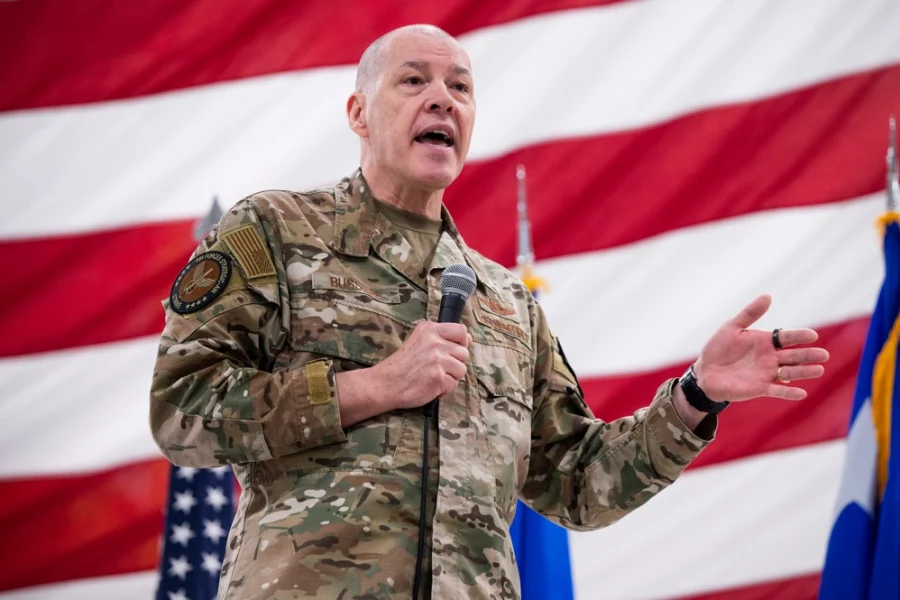Air Force Global Strike Command has a “detailed” plan in hand for how new B-21 Raiders will replace existing bombers in the coming years, boss Gen. Thomas A. Bussiere said. And while many details are classified, he did reveal that the command’s personnel numbers will expand “significantly” in the near future to handle that transition and a raft of other modernization programs.
While that end strength will eventually come down, it will remain higher than it is now, Bussiere added in an interview with Air & Space Forces Magazine.
With around 27,000 Active-Duty Airmen and 4,000 civilians, Global Strike is a relatively small Air Force major command. That number needs to go up, Bussiere said, to accommodate not only the B-21 but also new programs like the Sentinel intercontinental ballistic missile, the Grey Wolf MH-139 helicopter, and the Survivable Airborne Operations Center.
“All of these weapons systems are going to require us to initially ramp up to a significantly higher personnel number while we field the new capability, and then it will settle back down to a higher number than we have now, but not as high as we have to do in the transition years,” said Bussiere, who has been nominated to be Air Force vice chief of staff.
The B-21 will replace the B-2 and B-1; the Sentinel will relieve the Minuteman III; the MH-139 will replace the UH-1N; and the SAOC will succeed the National Airborne Operations Center. Yet Bussiere noted that the “unique requirements” of Global Strike Command’s nuclear mission means all of these transitions have to be seamless.
“We have to maintain full operational capability while we transition, because the nation is not going to give us a pause, right?” he said. “We have to provide our land leg and air leg capacity, our [nuclear command, control, and communications] capacity as we go through those transition years. And that’s, quite frankly, something we haven’t done in a very, very long time, if ever, with one weapon system, let alone all of them at the same time.”
Bussiere did not specify how big AFGSC might get in the coming years to handle that transition. It is likely to last through the end of the decade, given the current schedules for many of those modernization programs.
One of the biggest changes will be incorporating the B-21 into the bomber fleet. Bussiere said there is already a “detailed plan,” practically by tail number, specifying how new B-21s will be parsed out among three of Global Strike’s bases and replace B-1s and B-2s.
The growth in end strength is driven in part by shifting from a three-bomber force of B-1s, B-2s, and B-52s to a four-bomber force by adding B-21s, before ultimately settling into a two-bomber fleet of just B-21s and B-52s.
End strength will also be affected if the Air Force opts to buy more B-21s than its current requirement of 100 minimum.
- The first B-21s will bed down with the 28th Bomb Wing at Ellsworth Air Force Base, S.D. There will be “a host of operational squadrons and training squadrons” there, Bussiere said. As they arrive, the B-1s at Ellsworth will move out, joining those at Dyess Air Force Base, Texas.
- The second B-21 operating location will be with the 509th Bomb Wing at Whiteman Air Force Base, Mo., now the home base for all of the Air Force’s remaining B-2s.
- The third B-21 location will be with the 7th Bomb Wing at Dyess.
For some period of time, “we’ll have a number greater than our current B-1 and B-2 fleets,” Bussiere said. “We do have some capacity to expand at the existing three bases, depending on if the nation decides we need to buy more,” he noted, but then “we can look at other main operating bases if required.”
The B-1s that depart Ellsworth will operate at Dyess “as long as that platform is viable, to keep that weapon system alive until Dyess gets their B-21s in the later years,” he added.
The details of the succession plan are classified. So are the criteria that will determine what will constitute initial operational capability, though Bussiere noted that they include “number of airplanes, number of trained personnel, maintenance and support, and then the associated hardware and support equipment that go with it.”


